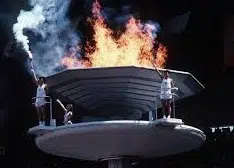The notion of cauldron refers to a container that is used to burn a perfume . The term can also refer to the vessel in which, in certain rituals or ceremonies, a flame burns .
 Cauldrons are similar to censers . These objects serve as stoves and are used to burn fragrant substances. In certain specific contexts , they adopt ceremonial use, as we mentioned above.
Cauldrons are similar to censers . These objects serve as stoves and are used to burn fragrant substances. In certain specific contexts , they adopt ceremonial use, as we mentioned above.
In the Olympic Games , cauldrons acquire great importance. Tradition indicates that the Olympic flame must be transported from Olympia to the place where the event takes place: once the cauldron is lit, it must remain burning throughout the competition.
The Olympic flame is linked to mythology . It is the commemoration of what was done by Prometheus , who stole fire from the gods and granted it to human beings. Already in the Ancient Olympic Games , the cauldron was lit so that the flame burned throughout the competition.
It should be noted that the Olympic Games in Amsterdam in 1928 were where, for the first time, the cauldron was lit directly from the Olympic flame. The person in charge of doing so was a worker from an electrical company in the city. Specifically, it was in these ninth Olympic Games of the Modern Age when the tradition of having the cauldron lit during the games was recovered.
On the other hand, it was during the Olympics held in Nazi Germany when the idea was introduced that the Olympic flame would travel from Olympia (Greece) to the place where those were going to be held, which in this case was Berlin. An idea that remains and that came from the mind of Carl Diem.
Currently, in each edition of the Olympic Games the flame is lit under the custody of the International Olympic Committee ( IOC ) and transported via the Olympic torch. This transfer is carried out through relays of athletes and personalities until, at the opening ceremony of the Games, some figure is in charge of lighting the cauldron.
At the 1992 Olympics, which were held in the Spanish city of Barcelona, the person in charge of lighting the cauldron of the games was the Paralympic archer Antonio Rebollo. This man, who was 36 years old, was in charge of shooting an arrow with his bow and lighting the cauldron that was located 86 meters away from him, in the highest area of the Montjüic Olympic Stadium.
50,000 people packed the stadium and more than 3.5 billion viewers followed that moment on television around the world. The nerves were evident, however, at 10:40 p.m. at night he lit the arrow and managed to shoot it with the necessary accuracy to light the aforementioned cauldron and start the 1992 Olympics.
In Atlanta 1996 , for example, Mohammed Ali was in charge of lighting the cauldron. The boxer, despite being affected by the effects of Parkinson's , completed the task before millions of people who followed the ceremony in the stadium and on television.
